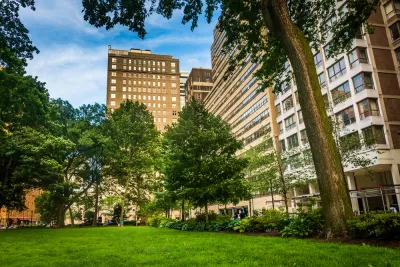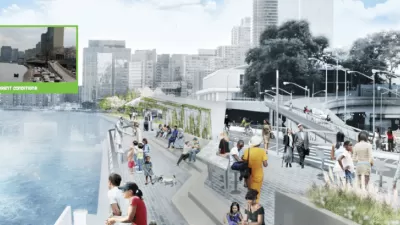Some people fear tall buildings near parks, asserting that such buildings will reduce sunlight. But because many parks are a block or more wide, this impact is likely to be minimal.

When I was running for Manhattan Borough President this fall, I had only one real debate focused on land use with my Democratic opponent (who won the election handily, as I expected). We did not have many areas of disagreement, but we did have different perspectives on one narrow issue: the relationship between sunlight and large-scale development, especially near parks. He was concerned that tall buildings near parks might negatively affect sunlight, because I live two blocks from Central Park and have never felt sunlight-deprived in the park, I was more skeptical.
My opponent then brought up a question about sunlight in smaller parks: In a park that is just one or two square blocks, could tall buildings block out the sun? I visited a park he mentioned and didn't see a problem. It was not really a fair test, however, since this particular park was separated from tall buildings by some fairly wide streets.
Later on, it occurred to me that Philadelphia (where I lived some years ago, and visited in 2020) has two downtown parks surrounded by at least some tall buildings: Rittenhouse Square and Washington Square. Rittenhouse Square is surrounded by numerous 10-20 story buildings, while Washington Square is next to some tall buildings and some shorter buildings. Both parks are mostly surrounded by narrow, pre-automobile streets—yet even a casual look at Google Street View shows that these parks have sun as well as shade.
In fact, it seems to me likely that parks near tall buildings are less likely to suffer inadequate sunlight than almost any street. In my experience, the least sunny streets in Manhattan are the oldest, narrowest streets of lower Manhattan. (To see an example, go to 99 John Street on Street View.) These streets are so narrow that tall buildings really can limit sunlight. By contrast, a wide street such as 34th Street or Fifth Avenue can be sunny despite the presence of tall buildings. As I wrote on this very site seven years ago, "the wider the street, the more sun."
It follows that if you are trying to ascertain the effect of tall buildings on park space, you should ask yourself: Is the park more like the 18th-century streets of Manhattan's Financial District, or more like mid-Manhattan’s wide avenues? Rittenhouse Square, like most significant public squares, is more than a block wide, which means that it is at least a few hundred feet wide—several times as wide as even an automobile-oriented stroad. So it seems to me unlikely that the tallest buildings would reduce sunlight at the heart of a park the size of Rittenhouse Square. It logically follows that if you are worried about the impact of tall buildings on sunlight, you should actually be less worried about placing them on parks than on ordinarily four-block wide American streets, and less worried about placing them on wide streets than on narrow streets.*
*Although I am not worried about either, for the simple reason that as the Earth cooks, we will want more shade than we needed a century ago. I also think that the public need for more housing should take priority, but I realize that this is less of a problem in most cities than it is in New York.

Planetizen Federal Action Tracker
A weekly monitor of how Trump’s orders and actions are impacting planners and planning in America.

San Francisco's School District Spent $105M To Build Affordable Housing for Teachers — And That's Just the Beginning
SFUSD joins a growing list of school districts using their land holdings to address housing affordability challenges faced by their own employees.

The Tiny, Adorable $7,000 Car Turning Japan Onto EVs
The single seat Mibot charges from a regular plug as quickly as an iPad, and is about half the price of an average EV.

As Trump Phases Out FEMA, Is It Time to Flee the Floodplains?
With less federal funding available for disaster relief efforts, the need to relocate at-risk communities is more urgent than ever.

With Protected Lanes, 460% More People Commute by Bike
For those needing more ammo, more data proving what we already knew is here.

In More Metros Than You’d Think, Suburbs are Now More Expensive Than the City
If you're moving to the burbs to save on square footage, data shows you should think again.
Urban Design for Planners 1: Software Tools
This six-course series explores essential urban design concepts using open source software and equips planners with the tools they need to participate fully in the urban design process.
Planning for Universal Design
Learn the tools for implementing Universal Design in planning regulations.
Smith Gee Studio
City of Charlotte
City of Camden Redevelopment Agency
City of Astoria
Transportation Research & Education Center (TREC) at Portland State University
US High Speed Rail Association
City of Camden Redevelopment Agency
Municipality of Princeton (NJ)






























